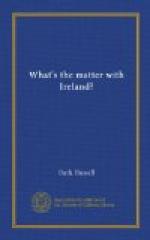[Footnote 5. “Reconquest of Ireland,” By James Connolly. Maunsel and Company. 1917. P. 328.]
IV
AE’S PEACEFUL REVOLUTION
“The co-operative commonwealth”
It was very dark. I could not find the number. The flat-faced little row of houses was set far back on the green. But at last I mounted some lofty steps, and entered a brown linoleum-covered hallway. In the front parlor sat the hostess. She was like some family portrait with her hair parted and drawn over her ears, with her black taffeta gown surmounted by a cameo-pinned lace collar. She poured tea. In a back parlor whose walls were hung with unframed paintings, a big brown-bearded man was passing teacups to women who were lounging in chairs and to men who stood black against the red glow of the grate. The big man was George Russell, the famous AE, poet, painter and philosopher, the “north star of Ireland.”
At last he sat down on the edge of a chair—his blue eyes atwinkle as if he knew some good secret of the happy end of human struggling and was only waiting the proper moment to tell. This much he did reveal as he gestured with the pipe that was more often in his hand than in his mouth: it is his belief that all acts purposed for good work out towards good. He gives ear to all sincere radicals, Sinn Feiners and “Reds.” But he states that he believes he is the only living pacifist, and disputes the value of bloody methods. He advocates the peaceful revolution of co-operation. His powerfully gentle personality has an undoubted effect on the revolutionaries, and while neither element wants to embrace pacifism, both want AE’s revolution to go forward with theirs.
His gaiety at the little Sunday evenings which he holds quite regularly, goes far, I am told, towards easing the strain on the taut nerves of the Sinn Fein intellectuals who attend them. On the Sunday evening I was present the subject of jail journals was broached. Darrell Figgis had just written one. In a dim corner of the room was miniatured the ivory face and the red gold beard of the much imprisoned Figgis.
“Why write a jail journal?” queried AE, smiling towards the corner. “The rare book, the book that bibliophiles will pray to find twenty years from now, will be written by an Irishman who never went to jail.”
Some one, I think that it was “Jimmy” Stephens, author of “The Crock of Gold,” who sat cross-legged on the end of a worn wicker chaise longue and talked with all the facility with which he writes, mentioned the countess’s plan of living in the Coombe district. AE returned that as far as he knew the countess was the only member of parliament who felt called upon to live with her constituency.
Then suddenly the whole room seemed to join a chorus of protest against President Wilson. At the Peace Conference all power was his. He was backed by the richest, greatest nation in the world. But he failed to keep his promise of gaining the self-determination of small nations. Was he yielding to the anti-Irish sentiment brought about by English control of the cables and English propaganda in the United States—was he to let his great republic be intellectually dependent on the ancient monarchy?




